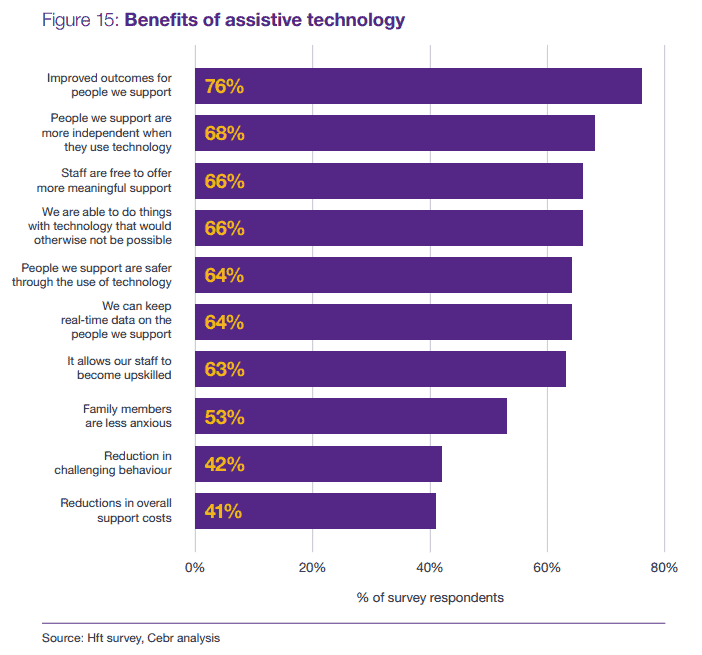
Technology – and assistive technologies in particular – came out as one of the key themes of hft’s latest Sector Pulse Check.
The report, which provides an annual snapshot of the financial health of the social care sector, surveyed a number of care organisations, including Care England, Learning Disability England and multiple UK care providers across learning disability care, elderly care, and physical disability care.
Core technology usage
Of those surveyed, hft found that 76% use assistive technologies of some type, but only 19% use it as a core part of service provision. One in five don’t use assistive technologies at all.
Hearing aids, smartphones and other devices that facilitate communicating are the most frequently used type of technology, used by 79% of respondents. Access solutions, such as doors with keyless entry and fingerprint recognition, came in second at 72%.
Other assistive technologies, such as apps, voice assistants (e.g. Amazon Echo), switch buttons and digital care recording (e.g. smartwatches) were all recognised within the survey, with around 30-55% of respondents confirming regular use.
Supportive technology

Of the organisations surveyed, there was an overwhelming agreement that assistive technology has provided continual improvements to the social care sector.
68% of respondents stated they have found that clients who use assistive technology are considerably more independent than those who don’t, with 76% reporting improved outcomes for those they support.
64% reported using assistive technology to keep real-time data on the people they support.
Thanks to technology, 66% of organisations went on to say they consider their staff have more time and freedom to offer more meaningful support. They are able to do things with technology that they wouldn’t be able to do otherwise.
It wasn’t only the care workers who found technology to be useful, 53% of client families promoted the use of technology, stating family members were ‘less anxious’ about their loved ones when technology allowed an almost constant connection.
Barriers faced
Although there has been significant progress in the use of assistive and supportive technology within the social care sector over the last few years, a number of barriers remain in place which prevents the full potential from being recognised.
The majority of those surveyed stated a lack of funding (75%) and lack of available training (59%) as the main barriers faced by the social care sector. There were also some limitations in the awareness of what technology is available to support the delivery of care.
Of the respondents, there were only 12% felt there were not enough assistive technology solutions to meet their needs.
Here at Unique IQ, we’re excited by technology’s potential to support care delivery and its impact on improving people’s outcomes. For more information about the technology we’re developing for home care, checkout IQ:caremanager.
Enjoyed this article?
Why not sign-up for regular updates? We promise to only send you the good stuff.
Or, you can read more right now on the Unique IQ blog.